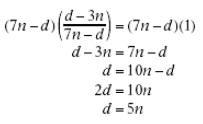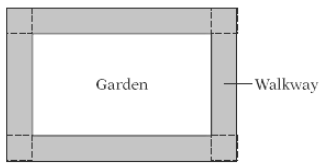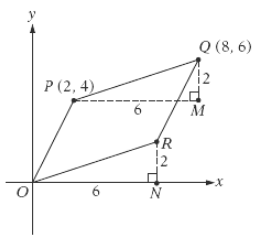GRE Mock Test (New Pattern) - 8 - GRE MCQ
30 Questions MCQ Test - GRE Mock Test (New Pattern) - 8
Directions: Choose the word or set of words that best completes the following sentence.
Deborah disliked her teacher’s rambling speeches; she wished he were more __________.
Directions: Choose the word or set of words that best completes the following sentence.
Although Todd tends to be ___________, he used a conversation partner to help him learn French.
Directions: Answer the questions based on following reading passage.
Whether the languages of the ancient American peoples were used for expressing abstract universal concepts can be clearly answered in the case of Nahuatl. Nahuatl, like Greek and German, is a language that allows the formation of extensive compounds. By the combination of radicals or semantic elements, single compound words can express complex conceptual relations, often of an abstract universal character[Line 5].
The tlamatinime (those who know) were able to use this rich stock of abstract terms to express the nuances of their thought. They also availed themselves of other forms of expression with metaphorical meaning, some probably original, some derived from Toltec coinages. Of these forms, the most characteristic in Nahuatl is the juxtaposition of two words that, because they are synonyms, [Line 10] associated terms, or even contraries, complement each other to evoke one single idea. Used metaphorically, the juxtaposed terms connote specific or essential traits of the being they refer to, introducing a mode of poetry as an almost habitual form of expression.
Q. Which of the following can be inferred from the passage regarding present-day research relating to Nahuatl?
Directions: Answer the questions based on following reading passage.
Whether the languages of the ancient American peoples were used for expressing abstract universal concepts can be clearly answered in the case of Nahuatl. Nahuatl, like Greek and German, is a language that allows the formation of extensive compounds. By the combination of radicals or semantic elements, single compound words can express complex conceptual relations, often of an abstract universal character[Line 5].
The tlamatinime (those who know) were able to use this rich stock of abstract terms to express the nuances of their thought. They also availed themselves of other forms of expression with metaphorical meaning, some probably original, some derived from Toltec coinages. Of these forms, the most characteristic in Nahuatl is the juxtaposition of two words that, because they are synonyms, [Line 10] associated terms, or even contraries, complement each other to evoke one single idea. Used metaphorically, the juxtaposed terms connote specific or essential traits of the being they refer to, introducing a mode of poetry as an almost habitual form of expression.
Q. In the context in which it appears, “coinages” (line 9) most nearly means
The increasing gap between the very rich and the desperately poor is one of the most _____ economic trends of our time.
Professors are often pressured to increase the grades of star athletes, however, I simply cannot do this, as I feel it violates my _____ as an instructor.
Directions: Answer the questions based on following reading passage.
Animal signals, such as the complex songs of birds, tend to be costly. A bird, by singing, may forfeit time that could otherwise be spent on other important behaviors such as foraging or resting. Singing may also advertise an individual’s location to rivals or predators and impair the ability to detect their approach. Although these types of cost may be important, discussions of the cost of [Line 5] singing have generally focused on energy costs. Overall the evidence is equivocal: for instance, while Eberhardt found increases in energy consumption during singing for Carolina wrens, Chappell found no effect of crowing on energy consumption in roosters.
To obtain empirical data regarding the energy costs of singing, Thomas examined the relationship [Line 10] between song rate and overnight changes in body mass of male nightingales. Birds store energy as subcutaneous fat deposits or “body reserves”; changes in these reserves can be reliably estimated by measuring changes in body mass. If singing has important energy costs, nightingales should lose more body mass on nights when their song rate is high. Thomas found that nightingales reached a significantly higher body mass at dusk and lost more mass [Line 15] overnight on nights when their song rate was high.
These results suggest that there may be several costs of singing at night associated with body reserves. The increased metabolic cost of possessing higher body mass contributes to the increased overnight mass loss. The strategic regulation of evening body reserves[Line 20] is also likely to incur additional costs, as nightingales must spend more time foraging in order to build up larger body reserves. The metabolic cost of singing itself may also contribute to increased loss of reserves. This metabolic cost may arise from the muscular and neural activity involved in singing or from behaviors associated with singing. For example, birds may expend more of their reserves on thermoregulation if they [Line 25] spend the night exposed to the wind on a song post than if they are in a sheltered roost site. Thomas’s data therefore show that whether or not singing per se has an important metabolic cost, metabolic costs associated with singing can have an important measurable effect on a bird’s daily energy budget, at least in birds with high song rates such as nightingales.
Q. The primary purpose of the passage is to
Directions: Answer the questions based on following reading passage.
Animal signals, such as the complex songs of birds, tend to be costly. A bird, by singing, may forfeit time that could otherwise be spent on other important behaviors such as foraging or resting. Singing may also advertise an individual’s location to rivals or predators and impair the ability to detect their approach. Although these types of cost may be important, discussions of the cost of [Line 5] singing have generally focused on energy costs. Overall the evidence is equivocal: for instance, while Eberhardt found increases in energy consumption during singing for Carolina wrens, Chappell found no effect of crowing on energy consumption in roosters.
To obtain empirical data regarding the energy costs of singing, Thomas examined the relationship [Line 10] between song rate and overnight changes in body mass of male nightingales. Birds store energy as subcutaneous fat deposits or “body reserves”; changes in these reserves can be reliably estimated by measuring changes in body mass. If singing has important energy costs, nightingales should lose more body mass on nights when their song rate is high. Thomas found that nightingales reached a significantly higher body mass at dusk and lost more mass [Line 15] overnight on nights when their song rate was high.
These results suggest that there may be several costs of singing at night associated with body reserves. The increased metabolic cost of possessing higher body mass contributes to the increased overnight mass loss. The strategic regulation of evening body reserves[Line 20] is also likely to incur additional costs, as nightingales must spend more time foraging in order to build up larger body reserves. The metabolic cost of singing itself may also contribute to increased loss of reserves. This metabolic cost may arise from the muscular and neural activity involved in singing or from behaviors associated with singing. For example, birds may expend more of their reserves on thermoregulation if they [Line 25] spend the night exposed to the wind on a song post than if they are in a sheltered roost site. Thomas’s data therefore show that whether or not singing per se has an important metabolic cost, metabolic costs associated with singing can have an important measurable effect on a bird’s daily energy budget, at least in birds with high song rates such as nightingales.
Q. The passage implies that during the day before a night on which a male nightingale’s song rate is high, that nightingale probably does which of the following?
[For the following question, consider each of the choices separately and select all that
apply.]
Directions: Answer the questions based on following reading passage.
Animal signals, such as the complex songs of birds, tend to be costly. A bird, by singing, may forfeit time that could otherwise be spent on other important behaviors such as foraging or resting. Singing may also advertise an individual’s location to rivals or predators and impair the ability to detect their approach. Although these types of cost may be important, discussions of the cost of [Line 5] singing have generally focused on energy costs. Overall the evidence is equivocal: for instance, while Eberhardt found increases in energy consumption during singing for Carolina wrens, Chappell found no effect of crowing on energy consumption in roosters.
To obtain empirical data regarding the energy costs of singing, Thomas examined the relationship [Line 10] between song rate and overnight changes in body mass of male nightingales. Birds store energy as subcutaneous fat deposits or “body reserves”; changes in these reserves can be reliably estimated by measuring changes in body mass. If singing has important energy costs, nightingales should lose more body mass on nights when their song rate is high. Thomas found that nightingales reached a significantly higher body mass at dusk and lost more mass [Line 15] overnight on nights when their song rate was high.
These results suggest that there may be several costs of singing at night associated with body reserves. The increased metabolic cost of possessing higher body mass contributes to the increased overnight mass loss. The strategic regulation of evening body reserves[Line 20] is also likely to incur additional costs, as nightingales must spend more time foraging in order to build up larger body reserves. The metabolic cost of singing itself may also contribute to increased loss of reserves. This metabolic cost may arise from the muscular and neural activity involved in singing or from behaviors associated with singing. For example, birds may expend more of their reserves on thermoregulation if they [Line 25] spend the night exposed to the wind on a song post than if they are in a sheltered roost site. Thomas’s data therefore show that whether or not singing per se has an important metabolic cost, metabolic costs associated with singing can have an important measurable effect on a bird’s daily energy budget, at least in birds with high song rates such as nightingales.
Q. It can be inferred from the passage that compared with other costs of singing, which of the following is true of the energy costs of singing?
[For the following question, consider each of the choices separately and select all that apply.]
Directions: Choose the word or set of words that best completes the following sentence.
Q. We were all drawn in by the twin babies' __________, wanting to __________ as many hugs as possible from the little __________ duo.
Directions: Choose the word or set of words that best completes the following sentence.
Q. My neighbor's well-behaved, __________ son displayed his patience and __________ while he sat still amidst the chaos, refusing to wander and __________ about.
Directions: Choose the word or set of words that best completes the following sentence.
Q. I feel such a strong sense of __________ at the __________ fees charged by my local bank that I am thinking of __________ banking institutions altogether.
Directions: Choose the word or set of words that best completes the following sentence.
Q. The __________ work of Isidore of Seville __________ all known topics of his era into a single text. It was named after his __________ methodology, which utilized grammar and history to explain the origins of the words listed in the tome.
Directions: Answer the questions based on following reading passage.
When marine organisms called phytoplankton photosynthesize, they absorb carbon dioxide dissolved in seawater, potentially causing a reduction in the concentration of atmospheric carbon dioxide, a gas that contributes to global warming. However, phytoplankton flourish only in surface waters where iron levels are sufficiently high. Martin therefore hypothesized that adding iron to iron-poor regions of the ocean could help alleviate global warming. While experiments subsequently confirmed that such a procedure increases phytoplankton growth, field tests have shown that such growth does not significantly lower atmospheric carbon dioxide. When phytoplankton utilize carbon dioxide for photosynthesis, the carbon becomes a building block for organic matter, but the carbon leaks back into the atmosphere when predators consume the phytoplankton and respire carbon dioxide.
Q. It can be inferred from the passage that Martin’s hypothesis includes which of the following elements?
[For the following question, consider each of the choices separately and select all that
apply.]
Directions: Answer the questions based on following reading passage.
When marine organisms called phytoplankton photosynthesize, they absorb carbon dioxide dissolved in seawater, potentially causing a reduction in the concentration of atmospheric carbon dioxide, a gas that contributes to global warming. However, phytoplankton flourish only in surface waters where iron levels are sufficiently high. Martin therefore hypothesized that adding iron to iron-poor regions of the ocean could help alleviate global warming. While experiments subsequently confirmed that such a procedure increases phytoplankton growth, field tests have shown that such growth does not significantly lower atmospheric carbon dioxide. When phytoplankton utilize carbon dioxide for photosynthesis, the carbon becomes a building block for organic matter, but the carbon leaks back into the atmosphere when predators consume the phytoplankton and respire carbon dioxide.
Q. It can be inferred that the author of the passage mentions predators (line 10) primarily in order to
[For the following question, consider each of the choices separately and select all that
apply.]
Unfortunately, the long-term _____ of using such pesticides was not known at the time, and many farmers used them widely without fully understanding their harmful properties.
In the more undeveloped, isolated parts of the country, farmers still practice the simple, time-honored techniques of their _____.
Directions: Answer the questions based on following reading passage.
Elements of the Philosophy of Newton, published by Voltaire in 1738, was an early attempt to popularize the scientific ideas of Isaac Newton. In the book’s frontispiece, Voltaire is seen writing at his desk, and over him a shaft of light from heaven, the light of truth, passes through Newton to Voltaire’s collaborator Madame du Châtelet; she reflects that light onto the inspired Voltaire. Voltaire’s book commanded a wide audience, according to Feingold, because “he was neither a mathematician nor a physicist, but a literary giant aloof from the academic disputes over Newtonian ideas.” In other words, Voltaire’s amateurism in science “was a source of his contemporary appeal, demonstrating for the first time the accessibility of Newton’s ideas to nonspecialists.”
Q. Which of the following statements about Voltaire’s Elements of the Philosophy of
Newton can be inferred from the passage?
[For the following question, consider each of the choices separately and select all that
apply.]
Directions: Select a single answer choice.
Q. If ![]() which of the following statements describes d in terms of n ?
which of the following statements describes d in terms of n ?
Directions: Answer the questions on following data.
Percent of Adjunct Faculty and Percent of Non-Adjunct Faculty at College X, by Field
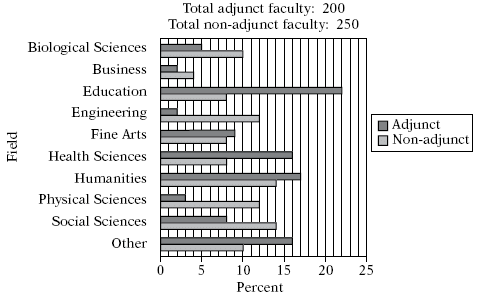
Directions: Answer the questions on following data.
Percent of Adjunct Faculty and Percent of Non-Adjunct Faculty at College X, by Field
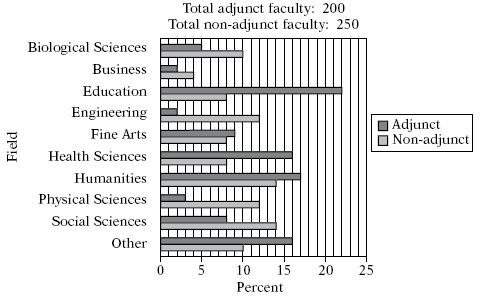
[Use the directions for Numeric Entry questions.]
Q. For the biological sciences and health sciences faculty combined, 1/3 of the adjunct and 2/9 of the non-adjunct faculty are medical doctors. What fraction of all the faculty in those two fields combined are medical doctors?
Directions: Your answer may be an integer, a decimal, or a fraction, and it may be negative. Enter the exact answer unless the question asks you to round your answer.
Q. The figure above represents a rectangular garden with a walkway around it. The garden is 18 feet long and 12 feet wide. The walkway is uniformly 3 feet wide, and its edges meet at right angles. What is the area of the walkway?
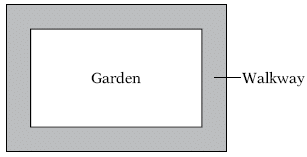
Directions: Directions: Select a single answer choice.
Q. Of the 700 members of a certain organization, 120 are lawyers. Two members of the organization will be selected at random. Which of the following is closest to the probability that neither of the members selected will be a lawyer?
Directions: compare Quantity A and Quantity B, using additional information centered above the two quantities if such information is given. Select one of the following four answer choices. A symbol that appears more than once in a question has the same meaning throughout the question.
Q. x2y > 0, xy2 < 0
Quantity A: x
Quantity B: y
Directions: Select a single answer choice.
Q. If x ≠ 0, which of the following is equivalent to ![]()
Directions: Select a single answer choice.
Q. Which of the following could be the graph of all values of x that satisfy the inequality ![]()
Directions: Select a single answer choice.
Q. Parallelogram OPQR lies in the xy-plane, as shown in the figure below. The coordinates of point P are (2, 4) and the coordinates of point Q are (8, 6). What are the coordinates of point R?
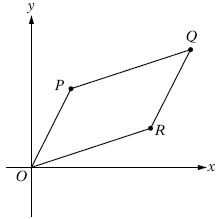
Directions: Select a single answer choice.
Q. The relationship between the area A of a circle and its circumference C is given by the formula A = kC2, where k is a constant. What is the value of k?
Directions: Select a single answer choice.
Q. The sequence of numbers a1, a2, a3, . . . , an, . . . is defined by ![]() for each integer n ≥ 1. What is the sum of the first 20 terms of the sequence?
for each integer n ≥ 1. What is the sum of the first 20 terms of the sequence?
Directions: Your answer may be an integer, a decimal, or a fraction, and it may be negative. Enter the exact answer unless the question asks you to round your answer.
Q. Line k lies in the xy-plane. The x-intercept of line k is −4, and line k passes through the midpoint of the line segment whose endpoints are (2, 9) and (2, 0). What is the slope of line k? Give your answer as a fraction.



